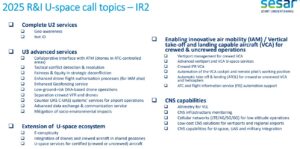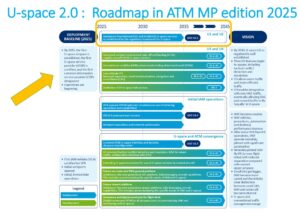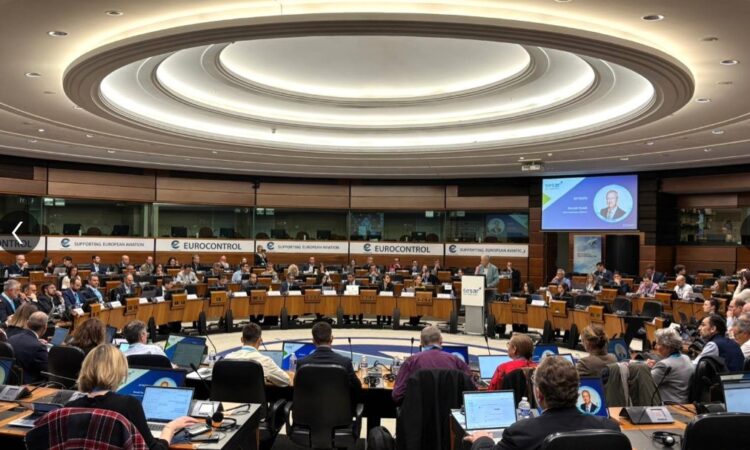By Philip Butterworth-Hayes
The end of fundamental large-scale U-space research projects in the European Union was the focus of the “Supporting the Drone Strategy 2.0” Brussels event last week organised by the Single European Sky ATM Research (SESAR) joint undertaking. The event brought together U-space experts from across the European Union to assess the progress and challenges of implementing U-space areas in the EU and provided attendees with an update of three critical three Digital Sky Demonstrators, U-ELCOME, BURDI.eu and EALU-AER, which for the last few years have been researching core U-space technologies and processes. These projects have all reached technical readiness level 8 – “Actual system completed and “flight qualified” through test and demonstration.”
This is not the end of EU-funded U-space research but it is perhaps the end of the beginning. There is still work to be done to develop critical paths to market for U-space companies and to support the pragmatic implementation of eVTOL operations. According to SESAR JU figures there are still 26 U-space related topics in the current call and some of these are critical – such as counter UAS (C-UAS) systems’ services for airport operations and vertiport management for crewed vertical capable aircraft. But as industry has multiple technology offerings for these services, these are arguably less strategic in nature than U-ELCOME, BURDI and EALU-AER and the budget is 60% less than previous EU-funded U-space research.

For drone operators the key question is: will all this work now translate into an accelerated uptake of U-space services throughout the continent unlocking the potential for more beyond visual line of sight (BVLOS) missions, now that the major technological questions have been answered? The slow uptake of U-space operations in Europe has always been less about the technology hurdles and more about national regulatory and certification complexities in parallel with uncertain income streams for U-space service providers.
According to Benoit Fonck, SESAR JU Chief Programme Manager: “In less than a decade U-space has moved from a strategic European objective to concrete implementation, supported by European Union Aviation Safety Agency (EASA) regulation. Across Europe, first services are now being deployed, enabling safe and efficient drone operations in real environments. This is a remarkable achievement — and one that Europe can be proud of.”

But what has been achieved since the first European Network of U-space Demonstrators was formed in October 2018?
Not much has moved since the last U-space adoption report in June this year: three approved common information service providers, three U-space service providers and 30 U-space airspace candidates. According to Tânia Cardoso Simões of EUROCONTROL: “We must now focus on expanding U-space deployment across more Member States and ensuring interoperability and consistency in service provision, collaborating with the standardisation bodies and regulators.”
Key challenges remain: expanding U-space deployment across more Member States, including ensuring interoperability and consistent service provision and engaging local communities and authorities to build trust around drone operations.
According to Jan-Christoph Oetjen, Member of the European Parliament, while the EU is pioneering in drones, rules don’t make a business, flights do.
“The discussions around multi-USSP integration via the CIS and digital flight authorisations show solid technical progress,” said Sebastian Babiarz of Skypuzzler in a Linkedin post. “Many flights have taken place, validating how authorities can approve or reject drone flight plans in real time. However, from the drone operator’s perspective, it still feels quite manual, not much different from what we saw in Geneva back in 2017, when skyguide and AirMap first showcased similar concepts. Despite advances like multi-USSP coordination, the scale of operations remains limited. It also makes me wonder: do we all share the same view on who truly benefits from U-space?”
This should not take away from the technical achievements which have been realised in the three major U-space demonstrators. These include:
U-ELCOME
- The “U-space implementation handbook” (available soon) compiles experience gained within and outside the U-ELCOME project to help stakeholders implement U-space services and operate them safely within U-space airspace.
- More than 600 operations in Spain validating advanced U-space concepts, including in Fuerteventura with a practical demonstration of the use of U-Space technology aimed at the automated management of drone and high-altitude pseudo-satellites (HAPS) integrated with conventional air traffic. including the drone operations carried out by Bluenest in Madrid (Hospital La Paz and Ocaña Aerodrome) and Sevilla port, where the Vertiport Control System (VCS) to ensure safe, connected, and real-time management of drone flights was implemented.
- Similar complex BVLOS operations conducted In Italy and France
- Demonstration of real-life use cases – such as in agriculture and at ports – and proved enhanced situational awareness for UAS operators and providers.
- Achieved certification of one Common Information Service Provider and one U-space Service Provider. The CISP was deployed to serve multiple USSPs, proving how different providers can work together seamlessly.
- Contribution to the development of U-space standards and the regulatory framework.
BURDI
- Developed the first cross-border U-space reference design between Belgium and the Netherlands – a pioneering step for European interoperability
- Developed a U-space Concept of Operations (ConOps) aligned with SESAR and CINEA requirements
- Conducted airspace risk assessments, stakeholder coordination mechanisms, and multilevel governance frameworks
- Executed demonstration flights, especially BVLOS drone operations in the Port of Antwerp/Antwerp Harbour geozone, integrating drone operations into complex and real-world environments
- Enabled a medical logistics trial: BVLOS drone flights between hospital sites in the Kempen region, reducing ground transport times from around 30 minutes to under 13 minutes
- Contributed to weather information services for U-space, advancing regulatory feedback and future improvements to U-space service design
- Engaged the drone community and ecosystem stakeholders, including surveys to assess U-space cost modelling and market uptake, to advance social acceptance.
EALU-AER
- Developed an infrastructure platform using modern UTM technology solutions, including a fully functioning vertiport, a U-Space platform, a backhaul network, communications and surveillance equipment, and advanced three-dimensional phased array radar.
- Major contributor to the demonstration of Ireland’s first all-electric aircraft flight, conducted by BETA Technologies at Shannon Airport. Throughout, four technology integration phases
- Demonstrated five use cases of Urban Air Mobility (UAM) that capture the operational requirements, vehicle dynamics, and technology demonstrations associated with the projected nearterm UAM services market.
- A comprehensive study on the societal acceptance of UAM operations across Ireland, examining the attitudes, expectations and concerns of citizens with respect to UAM, new business models and technologies. New roles and major changes in future workforce’s skills and competencies needed also assessed.
- A coordination process with the other Digital Sky Demonstrator projects and various regulatory and standardisation bodies to ensure consistency, integration, and consolidation at a pan-European level.
These are considerable technical achievements which now open the door even further to moving from research to commercial implementation. It will be up to States whether they decide to go through it.
For more information
https://www.sesarju.eu/DSDShowcase
(Image: SESAR)




